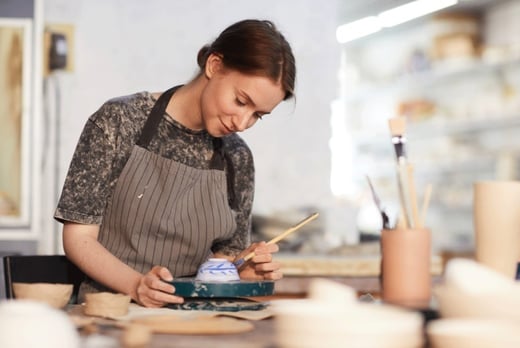A Complete Guide To Taking a Pottery Class and Navigating The World Of Craft

Have you ever wondered about how pottery is created? Or what cool colors and glazes are in the world of ceramics? Have you ever taken a class on pottery, but feel like you missed out on something while getting familiar with the techniques that create your favorite dishes and plates?
What Will You Learn in Pottery Class?
Pottery is a skill that can be learned quickly and easily, but it requires some practice to get good at it. In this guide, we’ll outline everything you need to know before taking a pottery class, including what you’ll learn and what tools you’ll need. Once you’re enrolled in class, be sure to follow the instructor’s instructions carefully and stay focused on your work!
How Long Does It Take to Finish a Piece of Pottery?
Learning how to make pottery is a fun and exciting process that can be enjoyed by anyone. Although the length of time it takes to finish a piece of pottery is different for everyone, the basics of the craft remain the same.
To start, you will need some clay and a kiln. You can find clay at most craft stores or online. Next, you’ll want to prepare your work area by cleaning it and arranging your tools accordingly. Most people prefer to work with a wheel, a potter’s wheel, and a firing table. Once you have your workspace set up, you can begin mixing the clay together according to the recipe you downloaded from the internet or learned from a pottery instructor.
The next step is to start shaping your pottery pieces. This can be done using many different methods including hand-building, coiling, shaving, and pressing. Once you have finished shaping your piece, it is time to fire them in the kiln. To do this, put your pieces on the firing table and adjust the temperature until they reach an appropriate point on the Kiln Temperature Scale (KTS).
Once they reach KTS temperature, turn off all but one of the gas flames in your kiln and place your pieces on top of that flame. Keep an eye on them as they will begin to climb up the fire column! When they reach the top of the column, turn off all but one of the gas flames in your kiln and let the pottery cool.
Finally, you can finish your piece by glaze it and add any finishing touches you may desire. Allow the glaze to dry completely before storing your pottery pieces away.
Tips for Getting Started in Pottery:
If you’re considering taking a pottery class, there are some basics you’ll want to know before you start. First, decide what type of pottery you’re interested in. There are many different types and styles to choose from, so if you’re not sure what kind of pottery appeals to you, consider browsing local galleries or museums.
Once you’ve decided on a style, the next step is to figure out what materials you’ll need. You can buy clay at most craft stores or even online, but be sure to read the material safety instructions before beginning. You’ll also need a kiln (or an oven that will reach temperatures high enough to turn your pots), firing rod and glaze (if applicable).
Now that your tools are ready, it’s time to get started! The first step in any pottery class is learning how to mix the clay and form it into desired shapes. Once the clay is shaped, it needs to be fired in a kiln or oven so that the material becomes hard and durable. To fire your pots, use a firing rod and keep an eye on the temperature gauge; too high of a heat can cause cracks in your pots.
Once your pots are finished firing, they need to be glazed. This step will give them their final look and finish; different types of glazes will change the color of your pottery, making it unique and special. If you’d like to learn more about glazing techniques, be sure to take a pottery class!
Traditional vs. Contemporary Crafts
When it comes to choosing the perfect craft class for you, there are a few things to keep in mind. Do you want something traditional, or more contemporary? Are you looking for an introduction to ceramics, or do you want to develop more advanced skills?

Here’s a quick overview of the two main types of crafts:
Traditional Crafts: These crafts date back centuries and involve a lot of hand-building and shaping. Examples include pottery, knitting, weaving, and quilting.
Contemporary Crafts: These crafts were developed in the 20th century and often use machinery and basic shapes to create objects. Examples include stamping, painting, woodworking, and metalworking.
If you’re interested in developing traditional craft skills but don’t know where to start, consider taking a pottery class. These classes cover everything from beginner basics like glazing and firing to more advanced techniques like slip casting and earthenware decoration. During the class, you’ll make several pieces of pottery that you can take home with you.
If you’re looking for something a little bit more contemporary, consider enrolling in a painting or sculpture class. In these classes, you’ll learn how to mix mediums and apply textures and colors to your work. You can also find classes that focus on specific themes or techniques, such as figure drawing or bronze casting.
No matter what type of craftsmanship interests you, there’s a class out there for you!
Recent Posts
 What are Some Common Mistakes to Avoid While Trimming Your Beard?
What are Some Common Mistakes to Avoid While Trimming Your Beard? A Guide to Updating Your Skincare Routine for Summer
A Guide to Updating Your Skincare Routine for Summer 5 Things To Keep In Mind When Ordering From A China Hair Factory
5 Things To Keep In Mind When Ordering From A China Hair Factory Why Moisturising Your Hands Is So Important?
Why Moisturising Your Hands Is So Important? What Is Your Curl Pattern Type, And How Do You Deal With It?
What Is Your Curl Pattern Type, And How Do You Deal With It? Dermal Fillers: What Are Dermal Fillers, How Are They Used, And Who Uses Them?
Dermal Fillers: What Are Dermal Fillers, How Are They Used, And Who Uses Them? How Filorga Optim Eyes Works
How Filorga Optim Eyes Works Reverse Balayage: A Low Maintenance Cost For Beauty in Winter
Reverse Balayage: A Low Maintenance Cost For Beauty in Winter Shape the Brows with efficient Eyebrows Tinting
Shape the Brows with efficient Eyebrows Tinting Different Types of Hair Extensions
Different Types of Hair Extensions
